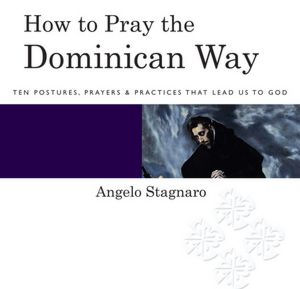
|
Posted October 8, 2012
Book: How to Pray the Dominican Way: Ten Postures, Prayers & Practices That Lead Us To God Author: Angelo Stagnaro Paraclete Press. Brewster, MA. 2012. pp. 151 An Excerpt from the Foreword:
Angelo Stagnaro not only encourages the reader to try these prayer postures for a week at a time, but he also gives very useful tips on how to get the most out of them while praying. He also uses the structure of The Nine Ways of Prayer as a framework to discuss various modes and approaches to prayer as suggested by the disposition that posture brings about. He is able to intelligently "unpack" each approach in simple, down-to-earth terminology. And so we examine together the Rosary, the Stations of the Cross, meditation in the Jesuit manner, the ancient mode of holy reading, or lectio divina, and the monastic meditation that disposes one for contemplation, which is treated in some depth. An Excerpt from the Book: Spiritual Reading Dominic's eighth way of prayer was dedicated to reading either the Bible, especially the Gospels, or a spiritual treatise. When he practiced lectio divina, the reading of spiritual topics with spiritual intentions, he would do so alone, away from others. Before opening the book, he would make the sign of the cross and then give thanks to God for the book itself, his literacy, and the opportunity to read the book before him. He would lift it above his head and offer his thanks, then bring it to his lips and kiss it. When reading the Gospels, he would cross himself upon the forehead, his lips, and once again upon his heart as believers do during Mass when the Gospel is read aloud. He took special care and reverence when he read Christ's very words. When doing so, he would cover his head and hide his face with the hood of his habit. At times he was brought to tears of joy and repentance. As Dominic read, he would focus intently on the text before him, making sure he engaged not only his faith but also his mind in deciding whether everything he read was appropriate and understandable. And, when he read a passage that was particularly moving, he would strike his breast, as Christians do during Mass, saying, "Mea culpa! Mea culpa! Or, literally, "I am responsible for my sins! I am responsible for my sins! I am very responsible for my sins!" When reading, we should move seamlessly from reading to prayer, from prayer to meditation, and from meditation to contemplation. After reading for a bit, Dominic would rise reverently and bow his head for a short time, offering a pray of thanksgiving. Wholly refreshed and in great interior peace, he then returned to this book. Table of Contents: A biography of St. Dominic de Guzman St. Dominic's Nine Ways of Prayer How to use this book First way Humbling oneself before the altar of God Second way Lying prostrate upon the ground Third way Concentrating upon the suffering of the world and one's death Fourth way Contemplating upon the crucifix and genuflecting Fifth way Standing before God Sixth way Standing in the cruciform position, contemplating Christ's passion and death and praying the rosary Seventh way Praying with hands held high in humble supplication Eight way Spiritual reading Ninth way Meditation as preparation to contemplation Tenth way Contemplation: the perfect prayer Conclusion Thousands of prayer forms Appendix Dominican resources |
|
